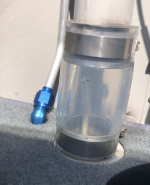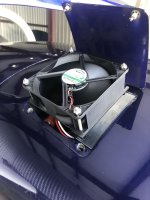Van's Air Force
You are using an out of date browser. It may not display this or other websites correctly.
You should upgrade or use an alternative browser.
You should upgrade or use an alternative browser.
RV12 912ULS Return Fuel Flow
- Thread starter JBHansen
- Start date
bbaggerman
Active Member
That is about what I show on my Dynon. I have always wondered if and how this is taken into account when the Dynon is showing fuel flow. If I am showing 5 GPH is that really 4 GHP for flight planning purposes?
I installed a fuel rated clear hose on my filler neck. I really like being able to see when the tank is full when refueling. One consequence is that I can see the fuel flow coming out of the return line. At first I was a little surprised at how low the flow is, but in retrospect it seems about right considering how much 1 GPH is. You can see how little comes out of the return line in the attached photo. The whole business of turning on the electric fuel pump to bring in cooler fuel to mitigate vapor lock now seems like pretty weak tea. Leave the pump on for 15 minutes and you get 1 Qt of liquid flow. I suppose it is better than nothing but not by much. I 3D printed a muffin fan mount to go over the cowl door and that does a great job of pulling the heat out from under the cowl.
I installed a fuel rated clear hose on my filler neck. I really like being able to see when the tank is full when refueling. One consequence is that I can see the fuel flow coming out of the return line. At first I was a little surprised at how low the flow is, but in retrospect it seems about right considering how much 1 GPH is. You can see how little comes out of the return line in the attached photo. The whole business of turning on the electric fuel pump to bring in cooler fuel to mitigate vapor lock now seems like pretty weak tea. Leave the pump on for 15 minutes and you get 1 Qt of liquid flow. I suppose it is better than nothing but not by much. I 3D printed a muffin fan mount to go over the cowl door and that does a great job of pulling the heat out from under the cowl.
Attachments
The whole business of turning on the electric fuel pump to bring in cooler fuel to mitigate vapor lock now seems like pretty weak tea. Leave the pump on for 15 minutes and you get 1 Qt of liquid flow.
If you analyze the RV-12ULS fuel system fwd of the firewall to determine what volume of fuel is in the lines and gascolator, you would find that it is way less than 1 quart.
The goal of the procedure is to purge the fuel that has been sitting static in the system, getting heated by the hot engine compartment.
(Note: this isn't nearly as effective if the canopy is fully closed for an extended period on a very hot sunny day which elevates the cockpit temp and then begins heating the fuel in the fuel tank above ambient).
The need to minimize heating of the static fuel in the portion of the fuel system fwd of the firewall is why opening the oil door is also recommended... to vent the cowl interior (the chimney effect is very active and will pull cooler air into the cowl interior through the exit opening at the bottom). All RV-12 owners should have their oil door hinges adjusted such that the door will stay open on its own.
Piper J3
Well Known Member
bbaggerman
Active Member
My fan looks like this. Works great! Love it!
Attachments
That is about what I show on my Dynon. I have always wondered if and how this is taken into account when the Dynon is showing fuel flow. If I am showing 5 GPH is that really 4 GHP for flight planning purposes?
There's only one fuel flow sensor, and it measures the fuel flow out of the tank. The return flow is not measured. The difference is "calibrated out" by adjusting the sensor calibration so that the fuel totalizer winds up with the right amount at typical cruise power and fuel flow.
I don't know about Garmin, but the Dynon EMS module does have the ability to have a separate intake and return sensor and use the difference between them. I'm not sure why Van's took the "single sensor and calibrate it out" approach - it seems a little janky to me (the return line is additive but the calibration is multiplicative). On the other hand, I suppose an extra sensor would be extra cost, build time, wiring, and another potential point of failure. In any case it seems to work well enough.
I did the clear fuel hose thing as well and have been very happy with it: https://vansairforce.net/community/showpost.php?p=1615861&postcount=362
There's only one fuel flow sensor, and it measures the fuel flow out of the tank. The return flow is not measured. The difference is "calibrated out" by adjusting the sensor calibration so that the fuel totalizer winds up with the right amount at typical cruise power and fuel flow.
I'm not sure why Van's took the "single sensor and calibrate it out" approach - it seems a little janky to me (the return line is additive but the calibration is multiplicative).
You answered the question yourself.
The computer can be made to be quite accurate for cross country flight since 90+% of the flight is at a steady state fuel flow. Cross country is really the only time computer accuracy is of value. Knowing an accurate total fuel burn while doing touch and goes in the pattern is not something most people care about, but even then it is usually pretty close because the power usually is modulated between WOT and a setting that is lower than what is typically used for cross country.
On the other hand, I suppose an extra sensor would be extra cost, build time, wiring, and another potential point of failure. In any case it seems to work well enough.
Yup, and yes it does.
Piper J3
Well Known Member
My fan looks like this. Works great! Love it!
Yes, you live where it is exceptionally warm... This morning I flew to breakfast and used the cooling fan at oil door opening. I returned to the airplane 45 minutes later and air flow from the fan was cool. Engine warm-up and long taxi downwind not a problem with residual heat...






